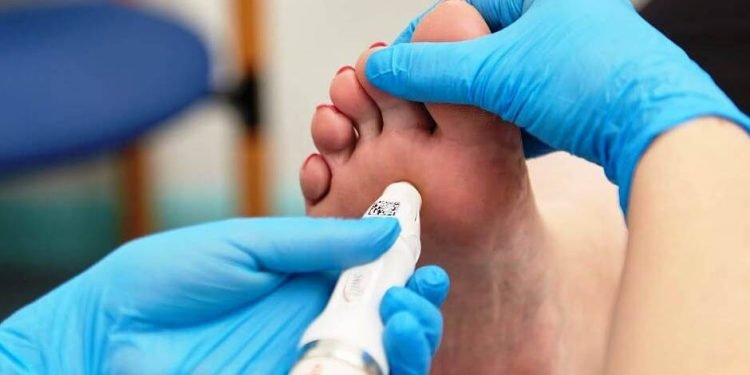People with diabetes are more prone to warts and foot problems because of poor circulation. Diabetes can also damage nerves making it difficult to recognize cuts and injuries in the foot. Regular checkups and diabetic foot care can help prevent the appearance and spread of warts and other infections. Some people assume warts will disappear on their own, but warts can spread and multiply. Here are four reasons why you shouldn’t ignore them:
1. They Can Get Worse
A verruca is a wart that grows at the bottom of your foot, sometimes called a plantar wart. Plantar is another name for the sole of your feet. Verruca warts are rough, somewhat round, and have tiny blood vessels resembling black dots beneath the hard skin.
The warts are caused by human papillomavirus strains that enter the feet via broken skin. Verruca warts are only a few millimeters initially, making them easy to miss or dismiss.
They can grow over time to become bigger than a centimeter wide. Standing, walking, and running can also exert pressure on the wart, causing more discomfort. Check your feet regularly to spot and treat verruca warts early.
2. They Can Spread Easily
Warts can become itchy, so you may be tempted to scratch a verruca. Scratching the growth may increase the risk of spreading the infection. The skin surrounding the verruca is more vulnerable to infection, especially as the wart grows.
Warts can spread easily and cause a cluster known as mosaic warts. Clusters may require more effort to treat, and the warts can spread to other parts of the body. The virus can also infect other people if you share towels, socks, mats, and other items.
People with warts or those who need diabetic foot care should wear shower shoes and socks inside their homes. Wearing socks and shoes protects your feet from dirt and objects that may cause an infection. Get regular checkups from your podiatrist.
3. They May Become Painful
Verruca warts affect the soles of your feet, which bear all your weight. The infection can cause tenderness, pain, and discomfort in the balls of your feet, making it difficult to stand, walk or run. For some people, the sensation may feel like stepping on a needle.
Some people with verruca warts start to limp and can develop knee pain, joint issues, and muscle aches. Limping can result in poor gait and posture, which may take a toll on your body.
Verruca warts are itchy at first but can become painful when you scratch them constantly. The pain can also worsen if the warts spread and go deeper into your foot. Treating verruca warts early may help prevent them from advancing to painful stages.
4. They Can Make You Inactive
Painful verruca warts only worsen if left untreated. This can keep you from an active lifestyle. You may find performing everyday activities like jogging, walking up the stairs, or playing your favorite sport challenging. Constant pain can also make it difficult to stand on your feet. Get prompt treatment to remove any warts and resume regular activity.
Staying active can boost circulation and promote healing. If verruca warts interfere with your gait and balance, seek medical help immediately. Your podiatrist can identify the best way to help you relieve the pain and keep you active.
Wart Removal for Diabetic Foot Care
People with diabetes can develop foot problems like warts, calluses, bunions, infections, and ulcers. Regular cleaning and podiatric checkups can help you spot foot issues like cuts and warts before they become serious problems. Wart removal is part of diabetic foot care offered by experienced podiatrists. Stick to reputable foot and ankle institutes offering diabetic care and solutions for warts, ingrown nails, heel pain, and skin conditions.












